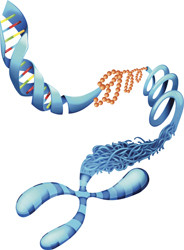Compartmentalisation of DNA repair
Cells continuously experience stress and damage from number of sources, such as UV light, irradiation, or oxidative by-products of metabolism. This endangers genome stability and could cause DNA breaks such as double strand breaks (DSBs). DSBs are the most harmful because their inaccurate repair can lead to chromosomal translocations. The EU-funded 'Nuclear architecture in DNA repair and formation of chromosomal translocations' (NADRCT) project investigates the role of nuclear architecture in the sensing and repair of DSBs. Preliminary findings suggest that nuclear compartmentalisation may contribute to the mechanism linking DNA damage response (DDR) and DNA repair. Researchers developed an experimental system to induce DSBs at specific locations and follow its repair. During first project period, they identified new repair factors involved in chromatin de-condensation. For instance, the polymerases TNKS 1 and 2 were found to be recruited to DNA lesions by the check-point protein MDC1 to promote reparative recombination. The same TNKS proteins counteract de-condensation and facilitate bridging of distal broken DNA ends. Using this system, researchers' visualised how breaks are recognised and repaired in the two different sub-compartments: the nuclear lamina and the nuclear pores. They showed that the DDR induced by a break inflicted at the nuclear lamina is delayed and the nuclear pores appear to be an activating microenvironment for DDR and repair. Finally, siRNA screening helped identify novel chromatin related proteins whose down regulation led to persistent and unrepaired DSBs. This approach revealed several novel proteins that are currently being investigated. Project outcomes revealed the role of chromatin structure in the differential regulation of DDR and repair at the two distinct compartments of the nuclear periphery. They reveal a new level of regulation of DSB repair through spatial organisation of DNA in the nucleus. This has important implications for the development of gene-based therapies.







